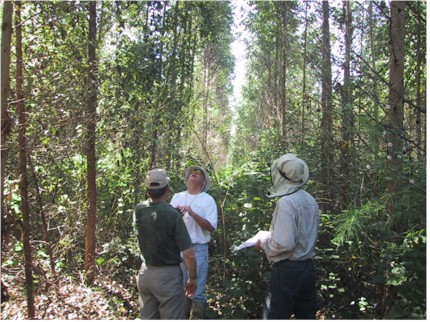  |

Planting Research Harvesting Research
Pictorial History of Site
|
||||||||||||||||||||||||||||||||||||||||||||||||||||||||||||||||||||||||||||||||
Energy Crop Yields for Eucalyptus and Cottonwoods. |
||||||||||||||||||||||||||||||||||||||||||||||||||||||||||||||||||||||||||||||||
Commercial Scale Planting Configurations: At our ~135 acre energy crop tree farm in Lakeland, three planting designs are used: Single Row Planting One row of trees planted per bed. On average, beds are spaced on 9 bart centers. Planting density is estimated to be 1,957 trees per acre. Harvesting on single row planted beds would use traditional equipment of skidders and fellerbunchers.
 Double Row Planting Two rows of trees planted per bed. On average, beds are spaced on 9 bart centers. Planting density is estimated to be 3,955 trees per acre. Harvesting on double row planted beds would use equipment currently utilizied for energy crop trees in Europe (e.g., Claas Harvester).
 Quadrupible Rows on Macro Beds/Mounds Four rows of trees planted per bed/mound. Beds spaced on 23 bart centers. Planting density is estimated to be 3,030 trees per acre. Harvesting on quadrupible row planted beds would also use Claas Harvester type equipment.
 Tree Yields: As of October 2003, most of our Single Row trees are two and one-half years old. Double and Quadrupible Rows trees are 1 and one-half years old. Two primary factors are limiting our ability to project our energy crop tree yields:
eucalyptus and cottonwood trees in such high planting densities per acre (i.e., traditional spacing is ~600 trees per acre). quadrupible spacings (not even two years old), making it difficult to project yield growth curves.
 Currently, the University of Florida (UF) is providing us their "very preliminary" estimates of yields on single row plantings:
As soon as UF's quantitative data becomes available we will post it. In the interim, any questions on these projections can be forwarded to Dr. Don Rockwood. Average Growth In Our Energy Crop Trees Per Year: averaging +40 feet in height.
|
|
|||||||||||||||||||||||||||||||||||||||||||||||||||||||||||||||||||||||||||||||
